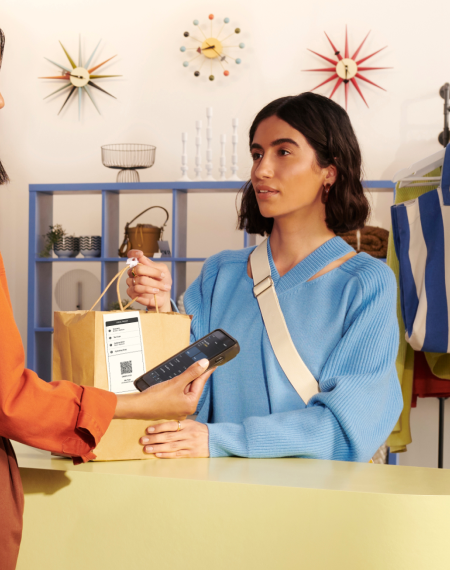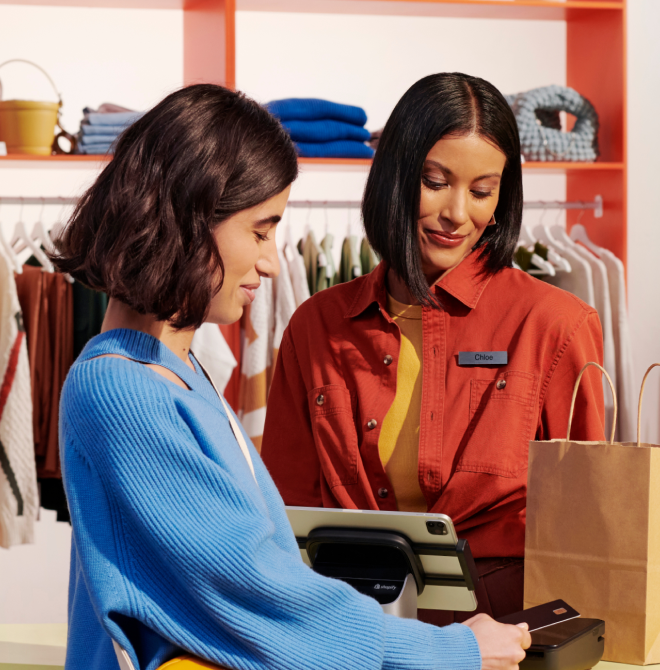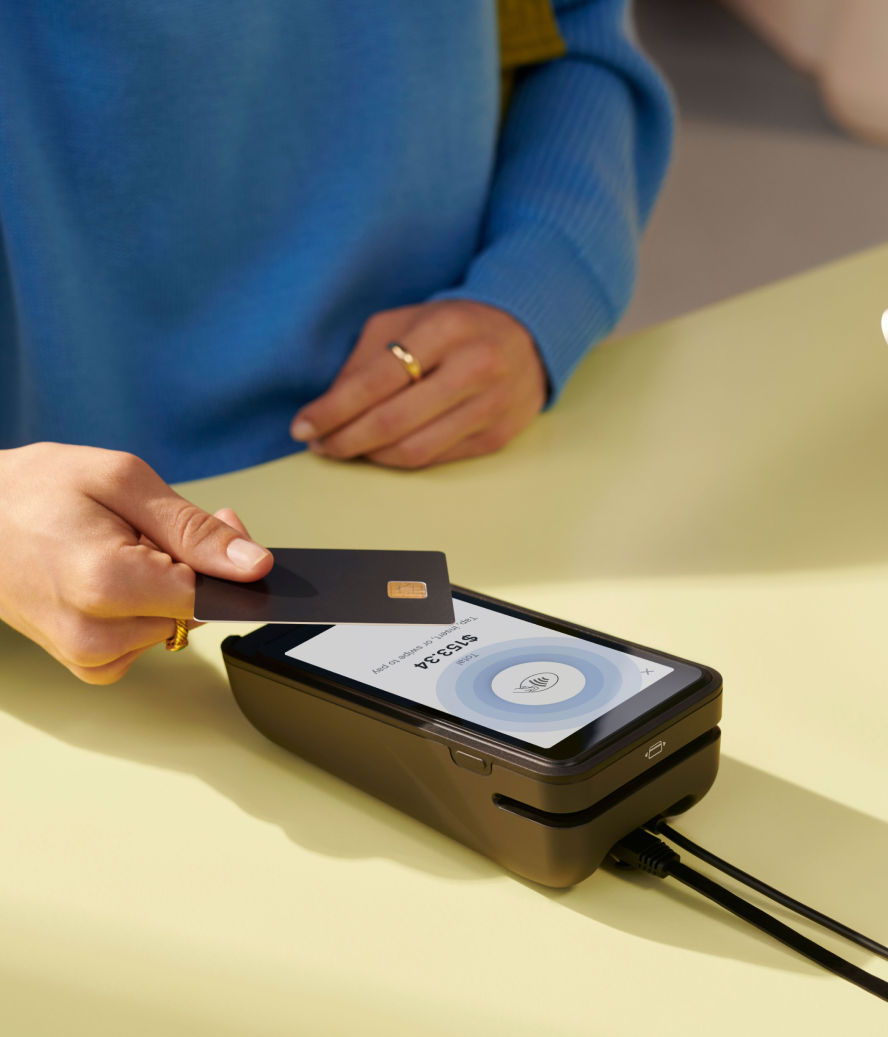When was the last time you left the house without your smartphone? If the mere thought of that makes you feel uneasy, you can join three-quarters of all Americans. Smartphone adoption is long past its infancy. Around 90% of the global population own a smartphone, and we’re using them for more than calling family or scrolling through social media.
Mobile commerce—the act of shopping from your cellphone—accounts for an estimated 68% of all retail sales. Why? Because it’s quicker and easier than remembering your credit card every time you want to shop.
Mobile payment processing lets you take advantage of the shift to mobile within your retail store. This guide shares how to implement it, the technology you’ll need, and the types of mobile payments you can accept.
What is mobile payment processing?
Mobile payment processing happens when a customer makes a transaction using their smartphone. Instead of relying on cash or chip-and-pin in-store, mobile payments are processed using technology such as near-field communication (NFC) on a smartphone. This gives consumers greater flexibility in how they pay for goods and services.
Not just a way for customers to pay, retailers also can use a mobile device to complete transactions in-store. Shopify’s Tap to Pay, for example, turns your cellphone into a mobile POS terminal. You can reference customer details, view inventory levels, and process transactions by turning your smartphone into a mobile card reader—without the need for a fixed checkout desk.
“I like the idea of not having to use the card reader,” says Daniel Vu, founder of Daniel Vu Ceramics. “It makes accepting contactless payments feel more seamless, and I can just send their receipt by text or email. My customers are really happy with the checkout process.”

How mobile payment processing works
Mobile credit card processing works when customers use their smartphones or RFID credit card to make a payment. Both use NFC technology to transmit payment details securely via radio wave, which the POS terminal picks up and uses to process the transaction. Most wallets have extra security features to ensure that the mobile transaction is authorized by the cardholder, such as fingerprint or facial recognition.
The process differs slightly depending on the type of transaction you’re processing. Customers who are making recurring payments, for example, might consent to the retailer vaulting their payment details. Future transactions can take place by either keying in their payment details on a card reader or using vaulted customer information to process the transaction.
Shopify makes this easier for merchants with unified customer profiles, which are part of its unified data model. These profiles centralize customer data—such as payment preferences, purchase history, and contact information—across all touchpoints.
Recurring billing is simple, since Shopify can automatically retrieve stored payment information from the unified customer profile. Even one-time payments are frictionless when customers use Shop Pay, which securely stores their payment and shipping details for instant checkout at millions of merchants.
Types of mobile payment solutions
Digital wallets
A digital wallet is an electronic payment method that customers use to pay for products via their smartphone. A digital wallet is an encrypted mobile wallet, either a smartphone’s native wallet (e.g. Apple Pay, Google Pay, or Samsung Pay) or a separate app such as Shop.
By 2027, Statista estimates that more than one-third of all US retail sales will be made with a digital wallet. That’s a stark increase from just 10% in 2020. Leading the shift is the convenience that mobile wallets offer. Customers don’t need to remember their details each time they want to make a purchase. There’s also no need to carry a physical card —they can use a device they’re already carrying.
Mobile wallets also keep customer’s payment details secure. When a customer pays for their order in-store using Apple Pay, for example, you don’t actually see their debit/credit card number. The wallet tokenizes those details to maintain the user’s privacy.
Peer-to-peer payment apps
If you’ve ever tried to send money to a friend or tip an entertainer, you’ll have likely encountered a peer-to-peer (P2P) payment app. Brands like PayPal, Venmo, and Cash App let users send money to other people with just their email address or phone number—no need to sign into your online banking and initiate the payment using the recipient’s account details.
Retailers don’t typically use P2P payment apps because vendors charge higher transaction fees for the luxury of easy transfers.
QR code-based systems
QR codes let customers point their smartphone camera to the image and be redirected to a secure payment link to complete their purchase. Apps like WeChat Pay and Alipay rely on this technology to give customers a touch-free way to complete their purchase.
Some retailers also use QR codes to cater to omnichannel shopping preferences. In-store shoppers might just be browsing or not have the option to take away a product the same day.
A mattress store, for example, could create a QR code that directs in-store shoppers to the product page on its ecommerce website. The customer can choose their specifications, select a delivery date, and pay for the mattress they’ve just trialled in-store.
Mobile point-of-sale (mPOS) solutions
A mobile point-of-sale (POS) system isn’t fixed to the checkout desk. Unlike countertop terminals, which are hardwired and offer limited flexibility, an mPOS system gives you the freedom to process payments from anywhere in-store.
Say, for example, that a retail associate is talking to a customer who’s interested in a pair of sneakers. The customer asks whether they’re available in a size 11. Instead of leaving the shopper mid-conversation to check inventory levels on a fixed countertop POS terminal, the associate can do so with a mobile POS device. The conversation isn’t disrupted; the shopper gets an immediate answer to their question (leaving less time to second-guess their purchase).
What’s great about mPOS solutions is that you don’t need to maintain specialist equipment. For example, Shopify Payments’s Tap to Pay feature turns your existing smartphone into a mobile POS device. It gives you the freedom to check customer data, process transactions, and take contactless payments from a device you already own.
“Whenever other entrepreneurs ask, I always recommend Shopify POS,” says Daniel Vu. “It’s easy to get started, reliable, and I can accept payments straight from my iPhone without any additional hardware.”

Contactless payments and NFC technology
Unlike traditional chip-and-pin transactions, contactless payments don’t require a customer’s card to physically touch a card reader. They use near-field communication (NFC) technology to send encrypted information from the card’s RFID tag to the POS terminal using radio waves.
Most banks offer RFID chips inside standard cards, so it’s no surprise that contactless payments are on the rise. It’s estimated that half of all US retail sales are contactless because the technology is easily accessible for customers. It’s also easy for retailers to accept credit card payments from their POS device.
Shopify Tap to Pay, for example, equips your smartphone with NFC technology. This means you can detect encrypted card details when the RFID tag from a customer’s card is placed beside it, without the need for a separate mobile card reader.
How to implement mobile payments in your store
The theory behind mobile payment processing sounds great. Here’s how to actually put it into practice within your retail store.
Choose the right merchant services provider
A merchant service provider offers a set of tools that retailers use to accept multiple payment methods in-store. They act as the intermediary between your business’s bank and your customers.
Here’s a shortlist of what to look for when choosing merchant services:
- PCI compliance. Every retailer is legally required to protect customer’s payment details to PCI standard. Check that your vendor’s software is PCI compliant to prevent unauthorized access or leaks that could lead to regulatory penalties.
- Pricing. Some merchant service providers charge a flat rate for their services; others charge tiered interchange rates. Before you commit, get clear on what your investment will be. Pay attention to contract lengths and hidden fees to get the full picture.
- Integrations. What tools are you already using to operate your store? From accounting software to shopping cart integrations, check that your merchant services provider integrates with this software for speedy implementation.
- Customer support. It’ll settle your mind to know there’s someone available if your payments system goes down. Check the vendor’s reviews and uptime reports, and ask other retailers for their experience before committing to a provider.
- Scalability. Migrating providers when you’ve outgrown your current solution is a time consuming and expensive process—one you can avoid by assessing the vendor’s scalability beforehand. Consider the features you might need as your retail operation grows, such as support for multiple currencies or varying sales tax rates. Shortlist vendors that meet these requirements.
Set up your hardware and software
A POS system is made up of two elements: hardware (the physical components that let you process payments, such as a mobile card reader or smartphone) and software (the operating system of said hardware). Most vendors offer both so you can mix and match your system depending on your needs. Follow their instructions to connect the two.
If you’d prefer to forgo a formal setup and opt to use your smartphone as a card reader instead, Shopify makes the process easy. Simply download the Shopify POS app and sign into your account to get started.
“The POS software itself, along with the hardware, is really easy to use,” says Corey Hnat, director of marketing at Pepper Palace. “Instead of troubleshooting our card readers, checkout is much smoother. We’ve shaved a good 10 to 20 seconds off each transaction, which adds up to big efficiency gains when you operate at our scale.”
Decide which payment methods to accept
There are plenty of factors to consider when choosing which payment methods to accept. Some transactions require a specialist credit card processor; others are naturally more expensive to process and eat into your profit margins.
Take stock of your current payment processing data. How do customers tend to pay for their products in-store and online? If mobile wallets take the lion’s share of online transactions, for example, it’s worth offering the same option in-store.
💡Pro tip: Unifying your sales data makes these business decisions easier. Shopify unifies your front- and back-end operations into one central source of truth, letting you blend in-store and online data for a complete view of your customers.
Train your staff
Retail associates and cashiers will be the people responsible for taking mobile payments in your store. Offer training that guides them through the process, and tips for troubleshooting common challenges.
If someone visits your store with a mobile wallet without realising their device has low battery, for example, teach cashiers how to email a personalized cart for the customer to complete their transaction at home.
Your choice of POS vendor heavily dictates how long this training process takes. Because Shopify unifies your data into a single system, there’s no need to train staff on different tools or technologies—it all happens in one place. This has helped brands such as Frank and Oak eliminate lengthy training sessions and reduce operating expenses associated with POS by 47%.
“We actually moved all 15 of our stores to Shopify POS in less than three months, including training the team,” retail operations manager Julia Rossi said of the migration. “Shopify has great training resources, and the POS interface was easy for our store associates to get accustomed to.”
Test and launch the mobile payment system
Once you’ve got the technical infrastructure setup, conduct a test transaction to confirm that the mobile payment processes properly. Add a low-value item to the cart and apply a discount code to make the total value $0.01. Use the new mobile payment method to process the transaction and confirm it goes through in your Shopify admin. Just remember to update your inventory quantities after the test.
Accept mobile payments with Shopify
If you're looking to modernize how you accept payments and unify your commerce operations, consider Shopify POS. Through Shopify Payments, you'll unlock powerful features like Tap to Pay, which turns your existing smartphone into a payment terminal without additional hardware.
As part of Shopify's unified commerce platform, you'll get more than just mobile payment capabilities. You'll have a complete system that connects your in-store and online operations, centralizes customer data, and enables seamless transactions across all channels—making it easier to grow your business while meeting modern shoppers' expectations.
Mobile payment processing FAQ
What are the steps for mobile payment?
The steps for completing a mobile payment are:
- The customer sets up their digital wallet (e.g. Apple Pay or Shop App).
- They connect their bank account or credit card.
- The customer visits a store or initiates an online purchase.
- In retail, they tap their smartphone onto NFC-enabled mobile credit card readers.
- In ecommerce, they open the wallet and authorize the transaction.
- The transaction is processed and completed.
What is the mobile payment method?
A mobile payment is any type of transaction that happens from a mobile device. For example, retailers can use Shopify Tap to Pay to take contactless payments from a customer’s device using their own.
What is the difference between mobile banking and mobile payment?
Most banks offer mobile apps that let customers check their balance and make payments. However, a mobile payment doesn’t require the user to sign into their mobile banking app. Mobile wallets secure their credit card details and allow customers to make purchases using NFC technology.
What is the largest mobile payment platform?
Apple Pay and Google Pay are the world’s largest payment platforms. AliPay, WeChat, PayPal, Cash App, and Venmo also make the shortlist.





